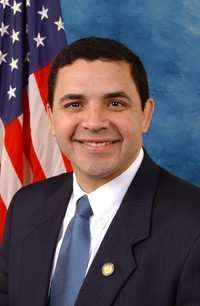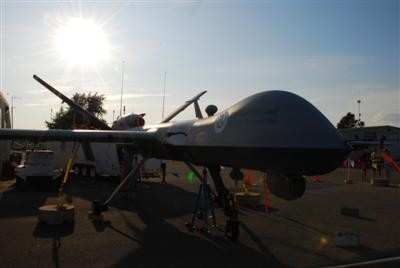Tue, May 25, 2010
Hopes To Use The Aircraft To Catch Illegal Immigrants,
Smugglers
 The U.S. Customs and Border Protection service (CBP) has
requested authority to expand their use of UAV's in Texas, notably
to fly along the gulf coast and the Rio Grande.
The U.S. Customs and Border Protection service (CBP) has
requested authority to expand their use of UAV's in Texas, notably
to fly along the gulf coast and the Rio Grande.
U.S. Representative Henry Cuellar (D-Laredo) hosted a meeting
late last week between FAA Administrator Babbitt and the CBP. The
Austin America Statesman reports that, following the meeting,
Cuellar expects that the new UAV will be approved by summer and in
operation by fall of this year. The aircraft would be based in
Corpus Christi.
"Last week, FAA gave CBP approval to fly from Arizona to West
Texas, and now we need clearance for the remaining 1,200 miles of
the Texas southern border," Cuellar (pictured, below) said in
a statement on his Congressional website. "These aircraft will
increasingly become a familiar means for providing homeland
security. The real time intelligence they provide will benefit our
domestic security strategy and give us a new tool to meet the
evolving threats of the 21st century. CBP has a vision to expand
this border security program and Texas is a part of that plan."

Currently, CBP Air and Marine operate several Predator B
unmanned aircraft systems along the northern and southern borders
of the United States. These remotely piloted aircraft have a long
duration of flight, up to 20-30 hours, and have provided to the
Department of Homeland Security critical national intelligence
information to secure the nation’s land borders. The new
CBP-operated UAV would provide real-time actionable information to
border patrol agents on the ground. This would allow border patrol
agents to immediately deploy response vehicles, boats, helicopters
or other aircraft to security situations along the border, as is
border security practice in other southern border states where UAVs
operate.
Pending FAA approval, the remotely-piloted aircraft could
provide CBP with air, land and marine intelligence to combat
illegal activity along the Rio Grande and Texas coastal waters
along the Gulf of Mexico. If the flight track is approved by the
FAA, CBP would have the operational capability to deploy a Predator
B land-based aircraft or a dual purpose land-marine Guardian
Maritime aircraft to the Texas-Mexico border this year.

Texas officials have long advocated the use of UAV's to patrol
the border, and the FAA's primary objection has always been safety
issues. "The FAA has moved cautiously in this area because of
concerns about the ability of these aircraft to operate in an
environment where other nonmilitary aircraft are present," FAA
spokesman Lynn Lunsford said.
More News
Also: 1st-Ever Space Crime Was a Fraud, IAE Buys Diamonds, Kennon Bows Out, Perseverance Rover An interesting moment came about this past Sunday as ANN CEO, Jim Campbell, noted tha>[...]
Have A Story That NEEDS To Be Featured On Aero-News? Here’s How To Submit A Story To Our Team Some of the greatest new stories ANN has ever covered have been submitted by our>[...]
From 2023 (YouTube Edition): Deviation from the Historical Mean Racine, Wisconsin-based DeltaHawk is a privately-held manufacturer of reciprocating engines for aircraft and hybrid >[...]
Smoke Began Entering The Cockpit During The Landing Flare, And Then The Pilot Noticed Flames On The Right Side Of The Airplane Analysis: The pilot reported that about 30 minutes in>[...]
Remote Communications Outlet (RCO) An unmanned communications facility remotely controlled by air traffic personnel. RCOs serve FSSs. Remote Transmitter/Receivers (RTR) serve termi>[...]
 Airborne 11.24.25: ANN's 30th!, Starships V3 Booster Boom, Earhart Records
Airborne 11.24.25: ANN's 30th!, Starships V3 Booster Boom, Earhart Records ANN FAQ: Submit a News Story!
ANN FAQ: Submit a News Story! Classic Aero-TV: DeltaHawk Aero Engine Defies Convention
Classic Aero-TV: DeltaHawk Aero Engine Defies Convention NTSB Final Report: Glasair GlaStar
NTSB Final Report: Glasair GlaStar ANN's Daily Aero-Term (11.22.25): Remote Communications Outlet (RCO)
ANN's Daily Aero-Term (11.22.25): Remote Communications Outlet (RCO)





